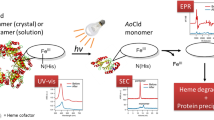Abstract
O2-jump experiments with an improved stopped-flow apparatus have been used to study oxygenation and deoxygenation processes in Lingula unguis hemerythrin. With an O2 electrode set in the observation cell, O2 concentration conld be obtained directly. The reliability of this method has been compared with other conventional methods.
O2-jump (up and down) experiments were carried out with L. unguis hemerythrin at pH 6.8 (non-cooperative pH) and at pH 7.6 (cooperative pH). At pH 6.8, both O2-jump (up) and O2-jump (down) experiments showed single exponential processes which were consistent with the following scheme: \({\text{Hr + O}}_{\text{2}} \mathop \rightleftharpoons \limits_{{\text{k}}_{{\text{off}}} }^{{\text{k}}_{{\text{on}}} } {\text{HrO}}_{\text{2}} \). The value of k on was estimated to be (4.4 ± 0.5) × 105 M−1 s −1, and k off was (15 ± 5) s−1. These values are consistent with those obtained by the temperature-jump method (Zimmer et al. 1986). At pH 7.6, O2-jump (up) experiments showed two relaxation processes, whereas O2-jump (down) experiments showed a single exponential process. The faster process in the O2-jump (up) experiments could be attributed to the same process as that seen in the temperature-jump experiments (Zimmer et al. 1986). The slower process in the O2-jump (up) experiments corresponds to the process obtained in the O2-jump (down) experiments. The results are discussed in terms of a state with intermediate affinity in O2-binding and with the possible existence of a slow step in O2-binding.
Similar content being viewed by others
Abbreviations
- Hr:
-
hemerythrin
- Hb:
-
hemoglobin
- CM:
-
carboxymethyl
- T-jump:
-
temperature-jump
References
Bates G, Brunori M, Amiconi G, Antonini E, Wyman J (1968) Studies on hemerythrin. I. Thermodynamic and kinetic aspects of oxygen binding. Biochemistry 7:3016–3020
DeWaal DJA, Wilkins RG (1976) Kinetics of the hemerythrin-oxygen interaction. J Biol Chem 251:2339–2343
Di Iorio EE (1981) Preparation of derivatives of ferrous and ferric hemoglobin. Methods Enzymol 76:57–72
Hagihara B (1965) Measurement of respiration with O2 electrode. Protein Nucl Acid Enzyme (in Japanese) 10:1689–1702
Joshi JG, Sullivan B (1973) Isolation and preliminary characterization of hemerythrin from Lingula unguis. Comp Biophys Physiol 44B:857–867
Kagaku Bin'ran (1980) Chemical data handbook, 3rd edn (in Japanese). Maruzen, Tokyo, pp 158–159
Klipenstein GL (1980) Structural aspects of hemerythrin and myohemerythrin. Am Zool 20:39–51
Klotz IM, Klipenstein GL, Hendrickson WA (1976) Hemerythrin: Alternative oxygen carrier. Science 192:335–344
Kurtz DM Jr (1986) Structure, function and oxidation levels of hemerythrin. In: Linzen B (ed) Invertiverate oxygen carriers. Springer, Berlin Heidelberg New York, pp 9–21
Kurtz DM, Shriner DF, Klotz IM (1977) Structural chemistry of hemerythrin. Coord Chem Rev 24:145–178
Loeher JS, Loeher TM (1974) Hemerythrin. A review of struc-tural and spectroscopic properties. Adv Inorg Biochem 1:235–252
Manwell C (1960) Oxygen equilibrium of brachiopod Lingula hemerythrin. Science 132:550–551
Minton AP, Imai K (1974) The three-state model: A minimal allosteric description of homotropic and heterotropic effects in the binding of ligands to hemoglobin. Proc Natl Acad Sci USA 71:1418–1421
Nelder JA, Mead R (1964) A simplex method of function minimization. Comput J 7:308–313
Petrou AL, Armstrong FA, Sykes AG, Harrington PC, Wilkins RG (1981) Kinetics of the equilibration of oxygen with monomeric and octameric hemerythrin from Themiste zostericola. Biochim Biophys Acta 676:377–384
Richardson DE, Reem RC, Solomon El (1983) Cooperativity in oxygen binding to Lingula reevii hemerythrin: spectroscopic comparison to the sipunculid hemerythrin coupled binuclear iron active site. J Am Chem Soc 105:7780–7782
Richardson DE, Emand M, Reem RC, Solomon El (1987) Allosteric interactions in sipunculid and brachiopod hemerythrins. Biochemistry 26:1003–1013
Tachi'iri Y (1986) Kinetic study of oxygenation of hemerythrin with stopped-flow of direct O2 measurement type in the ob-servation cell. Master thesis of Science University of Tokyo
Wilkins RG, Harrington PC (1983) The chemistry of hemerythrin. Adv Inorg Biochem 5:51–85
Zimmer J, Tachi'iri Y, Takizawa H, Handa T, Yamamura T, Kihara H (1986) Kinetic study of the oxygenation process of hemerythrins from Lingula unguis and Siphonosoma cuma-nense. Biochim Biophys Acta 874:174–180
Author information
Authors and Affiliations
Additional information
Offprint requests to: H. Kihara
Rights and permissions
About this article
Cite this article
Tachi'iri, Y., Ichimura, K., Yamamura, T. et al. Kinetic study on oxygenation of Lingula unguis hemerythrin using the stopped-flow 02-jump method. Eur Biophys J 18, 9–16 (1990). https://doi.org/10.1007/BF00185415
Received:
Accepted:
Issue Date:
DOI: https://doi.org/10.1007/BF00185415




